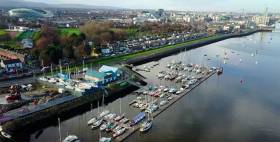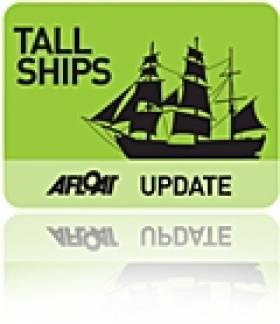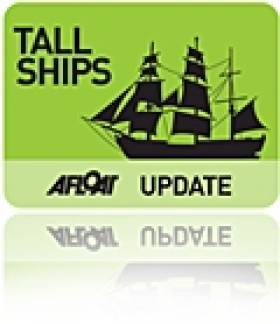Displaying items by tag: Dublin Riverfest
#SpectatorStand - Looking back on the fifth Dublin Port Riverfest held over the June bank holiday the Liffey event attracted record crowds thronging the North Wall Quay, writes Jehan Ashmore.
On the Saturday alone a record 41,500 visitors attended out of an estimated 100,000 that were expected to the festival that coincided with mostly favourable weather! This was no doubt an added bonus for those boarding the customary line-up of tallships.
The free-admission tallships totalling eight included schooners which kept the crews busy. Among them was notably the replica Russian tallship Shtandard and the festival highlight of the 'Parade of Sail'.
In addition to dry-land based retro drive-in movies and a children's entertainment zone that featured a rock-climbing wall... Perhaps this will assist those budding sailors to climb the rigging!
As for dignitaries, Lord Mayor of Dublin and Honorary Admiral of Dublin Port, Brendan Carr officially opened the festival that saw people of all ages gather for the tallships and quayside marquees where food outlets were available as part of a newly expanded festival site.
Also new for Riverfest was a purpose-built spectator stand that was a novel feature for an Irish maritime festival. The stand was especially erected to overlook the tallships, the flyboarding antics of Jet Man and of course those ThunderCats!... as previously covered here on Afloat.
This was Thundercats Dublin debut which saw these high speed craft race daily. Crowds were drawn to include those viewing from the aforementioned spectator stand as the boats whizzed on the Liffey. Almost directly to the rear of this temporary structure stands the looming presence of the new headquarters of the Central Bank of Ireland, see related river-restaurant ship story.
Also on hand for Riverfest goers were water-based activities, from stand up paddle boarding (SUP-ing) to sailing and kayaking. In addition from the pontoon located next to the Tom Clarke toll bridge there were boat tours of the river providing an alternative on the water experience.
#Joyride - Two men appeared in court in Dublin yesterday (Thursday 1 June) over a boat chase on the River Liffey that surprised early morning commuters in the capital.
Brian Stacey and Ronan Stephens, both of Crumlin in south-west Dublin, face a number of charges relating to theft of a pleasure craft and boating under the influence of alcohol, according to The Irish Times.
Dun Laoghaire RNLI and the Dublin Fire Brigade were among the emergency services that responded to the incident around 6am yesterday after the €11,000 boat was taken from Poolbeg Yacht & Boat Club, which is preparing for this bank holiday weekend’s Dublin Riverfest.
The Irish Independent reports that a number of men on board the boat taunted those chasing them as they drove erratically through the Dublin Port shipping lanes east of the Eastlink Bridge, interfering with the passage of a cruise liner.
The boat was then pursued further up the Liffey, where it was finally halted at St John Rogerson’s Quay.
Both men arrested after the incident have been released on bail.
Dublin Riverfest's 'Parade of Sail' Marks Port Farewell
#DublinPardeofSail – The Parade of Sail on the Bank Holiday Monday, marked the end of another Dublin Port Riverfest, as the varied fleet in terms of type and age transited the East Link bridge bound for Dublin Bay, writes Jehan Ashmore.
One of the smaller tallships, the Welsh Vilma headed the Parade of Sail, following a 'Battle of the Pirate Ships' complete with 'cannon' fire which was held within the Liffey's central city quays to the delight of onlookers.
The Beaumaris registered vessel had on another occasion called to Dublin Bay to anchor in Scotsmens Bay during the MOD70 races in 2012.
Also participating in the capital, was the smartly kept ketch of the Irish Naval Service, the sail training vessel STV Creidne, the distinctive black and white strip hull of the Pelican of London and the largest visitor, Gulden Leeuw which represented the final departure.
Some of the tallships as soon as they passed through the almost thirty year-old bridge, berthed at the Poolbeg Yacht & Boat Club.
The river berths of the marina soon saw a quartet of vessels berth in quick succession, one been the century-old Cornish based Ruth.
Should you have not seen the tallships gracing the capital quays, there's another opportunity to see the forest of masts as they call to the Irish Maritime Festival (14-15 June) along the quays of Drogheda Port.
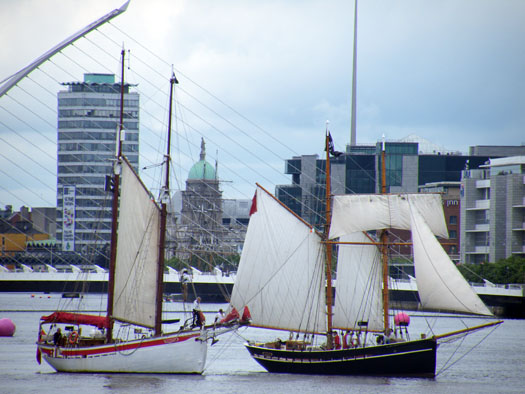
Soteria and Vilma
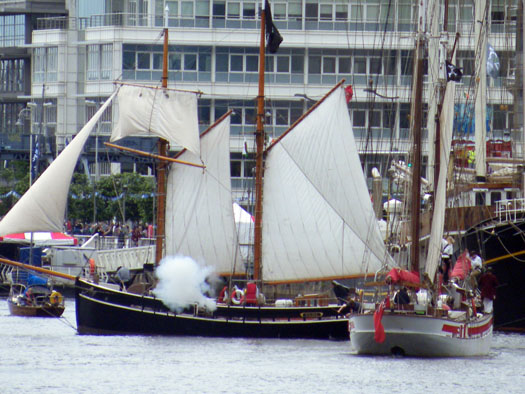
'Pirate ships' in battle -Vilma and Soteria
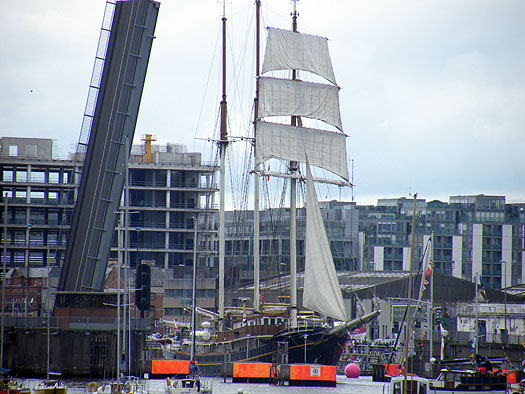
Gulden Leeuw, the largest tall ship on the Liffey
The event likewise of the Riverfest is organised by a port authority in association with others, in this case the Drogheda Port Company. The Louth port will also welcome a non-Dublin caller, as previously reported the 110 year-old classic West Country trading ketch, Bessie Ellen to the Boyne.
Making a debut to the second year of the festival is another classic vessel, in the form of the working hopper dredger, Hebble Sand, albeit more than half a century old herself.
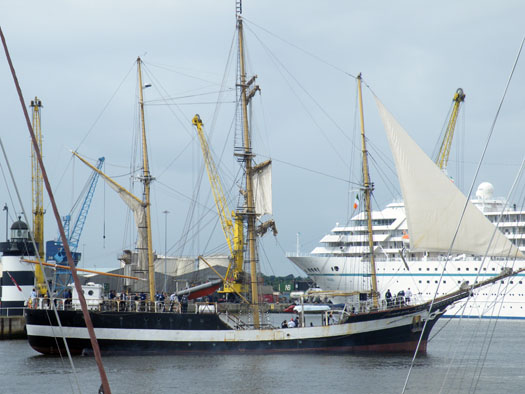 Pelican of London departs Dublin Port
Pelican of London departs Dublin Port
#TallshipsDublinRiverfest - Lining the Liffey quays are a flotilla of tall ships for Dublin Port's 'Riverfest', the second time the sailing and maritime festival has been held and where the public can board these beautiful vessels free of charge, writes Jehan Ashmore.
The bank holiday weekend held Riverfest (31 May-2 June) welcomed visiting tall ships which berthed today along North Wall Quay, from where the public will be able to thread timber decks and meet some pirates too! In addition to other events and activities held along the quays, for details visit the festival programme.
Among the vessels previously reported, is veteran Ruth, a century-old gaff-rigged schooner built in Sweden to serve in the Baltic, now the Penzance based vessel offers sailing holidays. The Cornish vessel had anchored in Killiney Bay off Sorrento Point, Dalkey and from noon she met fellow tallships in Dublin Bay before heading in to the city-centre berths.
The flotilla was met by the Naval Service STV L.E. Creidne which led them into the the port channel and through the East-Link bridge.
Also making an appearance is L.E. Roisin (P51) the leadship of a class of Offshore Patrol Vessels in which the design of the new L.E. Samuel Beckett (P61) is based upon. Another grey hulled vessel on view will be a Revenue Commissioners custom cutter.
Not to be missed are tugs dancing!... yes that's right, as Dublin Port's pair of tugs get into the action too with an impressive display on the river. The starring tugs are the green hulled Beaufort and Shackleton.
Of the larger tall ships, they are the 70m Gulden Leeuw, the 45m Pelican of London which is take part in the Drogheda's Irish Maritime Festival in mid-June and 48m Morgenster. On board the trio were around 100 youngsters from the north and the rest of this island nation. The latter vessel having called to Belfast this week to announce the return of the Tall Ships Races to the city next year.
As for the Ruth, the schooner has company with counterparts, Irene, Soteria and Vilma adding to the sense of a traditional bygone era of sail. Plus our very own replica barque, Jeanie Johnston, again free tours telling the story of famine and emigration to the US.
Another Liffey ‘resident’ is the Dublin built TSMV Cill Airne, a rivetted hulled former Cobh liner tender now restaurant venue where an Admirals Ball is to be held on Sunday.
It is understood that the berths for the tallships are moored alongside new pontoons which will remain permanent following the Riverfest's finale when on Monday there will be a 'Parade of Sail'.
#TallShipsDublin2014 – It's that time of year again, as the second Dublin Port 'Riverfest' gets underway over this June Bank Holiday weekend (31 May-2 June), and already in port are a flotilla of almost ten tallships lining the Liffey quays, writes Jehan Ashmore.
The host organisers of the riverside, sailing and maritime festival, Dublin Port Company welcomed a majestic array of tallships that arrived from noon onwards today to berth along the capitals historic North Wall Quay.
One of the visiting vessels is the 100 year-old Ruth, which had been at anchorage in Killiney Bay, off Sorrento Point in Dalkey, having sailed from Milford Docks in Pembrokeshire. She is operated by First Rate Sail, a family-run sailing holiday business based in Penzance, Cornwall.
The Swedish built gaff-rigged schooner traded in the Baltic Sea and these days she offers sailing voyages in Irish waters, Cornwall, Isle of Scilly, Brittany and Seine Bay off Normandy.
As previously reported the Riverfest festival programme will include the tallships, among them our very own the Jeanie Johnston, the replica barque will be open free of charge.
The River Liffey will take centre stage, as the three day festival is expected to be one of the biggest family-friendly events this weekend, attracting thousands of Dubliners and visitors to enjoy a wide range of quayside seafaring events and activities.
Two pirate ships featuring pirate re-enactments will be held, while Dublin Port will put on a show of their own with tug boat "dance" demonstrations performed by sisters Beaufort and Shackleton. Watch the skill of the tug-boat crew's within the confines of the Liffey.
In addition to river kayaking and most importantly is the sailing spectacle which is to culminate in a 'Parade of Sail' on Monday.
Fingers crossed that the winds will pick up in Dublin Bay to fill those white canvas sails while we bid them fare sailing!
#ClassicShip – It won't be all about vessels under sail as the veteran T.S.M.V. Cill Airne, which served as a trans-Atlantic passenger liner tender in Cobh, will be open to the public as part of the inaugural Dublin Port River Festival (1-3 June), writes Jehan Ashmore.
Throughout the three-day festival, the Cill Airne will have an Open Day between 11am to 6pm.
Since 2006, the Cill Airne has been moored as a static restaurant and bar venue along Dublin's North Wall Quay.
As previously reported on Afloat.ie, last year she celebrated a major milestone, having been built 50 years ago at the nearby old Liffey Dockyard.
To celebrate her half-century, the Irish branch of the World Ship Society (WSS) based in Cobh held a special luncheon on board in the beautiful timber surroundings of the Quay 16 Restaurant.
The 500 tonnes vessel is also unique in that she is the last ship built from the yard.
Research has indicated that she along with her sister Blarna were built with rivetted hulls, this was a political one, designed to ensure employment of the last riveting crews at the dockyard.
This made Cill Airne unique to Dublin's maritime industrial heritage but also significant in that this outdated shipbuilding technique was still in practise in a European shipyard.
Why not come on board during the festival and explore this rare example of a surviving Irish built vessel.
In addition the upper decks will provide an opportunity to gain a higher elevation of the myriad of boating traffic and with Tallships berthed either side along the quays.
On Saturday the Howth 17's, the world's oldest one-design keelboat class still racing will indeed be doing just that!...and on Sunday the Old Gaffers 'Parade of Sail'.


























